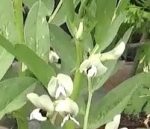 Horse bean is a cool weather annual and a member of the pea family, Fabaceae, that also includes lupines, mimosa, and black locust. It is native to the eastern Mediterranean area where it has been grown and consumed since 6000 BC or earlier. The plants grow 1.5-6′ tall and have 2-4 stems that are square in cross-section. The pinnate gray-green leaves are 4-10″ long and have 2- 7 leaflets. The summer-blooming flowers are very fragrant and have 5 petals, 2 white standard petals, 2 white wing petals with a black spot, and a white keel petal. The fruit is a leathery pod that is green maturing to dark blackish brown, has a downy surface and contains 3-8 round to oval seeds. The seeds of horse bean are intermediate is size between the larger broad bean seeds and the smaller pigeon bean seeds. Although eaten by humans in ancient times, horse beans are now grown as animal feed and for soil improvement as bacteria in the root nodules fix nitrogen in the soil. The genus name, Vicia, is the classical Latin name for vetch. The specific epithet, faba, is the classical Latin word meaning bean. The variety name, equina, is from the classical Latin word equus, meaning horse, and refers to the use of the bean for horse feed.
Horse bean is a cool weather annual and a member of the pea family, Fabaceae, that also includes lupines, mimosa, and black locust. It is native to the eastern Mediterranean area where it has been grown and consumed since 6000 BC or earlier. The plants grow 1.5-6′ tall and have 2-4 stems that are square in cross-section. The pinnate gray-green leaves are 4-10″ long and have 2- 7 leaflets. The summer-blooming flowers are very fragrant and have 5 petals, 2 white standard petals, 2 white wing petals with a black spot, and a white keel petal. The fruit is a leathery pod that is green maturing to dark blackish brown, has a downy surface and contains 3-8 round to oval seeds. The seeds of horse bean are intermediate is size between the larger broad bean seeds and the smaller pigeon bean seeds. Although eaten by humans in ancient times, horse beans are now grown as animal feed and for soil improvement as bacteria in the root nodules fix nitrogen in the soil. The genus name, Vicia, is the classical Latin name for vetch. The specific epithet, faba, is the classical Latin word meaning bean. The variety name, equina, is from the classical Latin word equus, meaning horse, and refers to the use of the bean for horse feed.
Type: Annual
Bloom: Very fragrant 5 -petaled flowers with 2 white standard petals, 2 white wing petals with a black spot, and a white keel petal, in summer
Size: 1.5-6′ H
Light: Full sun
Soil: Average, heavy, moderately moist, well-drained loam
Hardiness: Cool weather annual
Care: Low maintenance
Pests and Diseases: aphids, chocolate spot (Botrytis fabae and B. cinerea), rust (Uromyces viciae fabae), black root rot (Thielaviopsis basicola), stem rots (Sclerotina trifoliorum, S. sclerotiorum), root rots and damping-off (Rhizoctonia spp.), downy mildew (Pernospora viciae), pre-emergence damping-off (Pythium spp.), leaf and pod spots or blight (Ascochyta fabae), foot rots (Fusarium spp.), bean yellow mosaic virus, bean true mosaic virus, and bean leaf roll virus.
Propagation: Seed
Companion Plants: Plant as manure crop